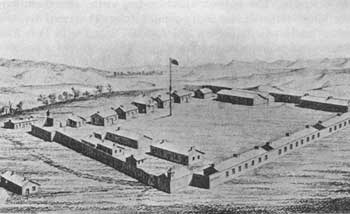
National Archives The Long First Winter The snowy winter passed with infrequent mail. Stories were passed by the Crow to the soldiers at Fort C.F. Smith of the Fetterman Fight. Eighty-one soldiers who pursued attacking Sioux away from Fort Phil Kearney were lured to a larger force of Indians that killed them all on December 21st. Due to brutal winter weather, the details of the Fetterman Fight were not confirmed at Fort C.F. Smith until February 7, 1867. By May, the only food left at the fort was corn originally intended for the livestock. Life was hard and lonely at the isolated post. On May 26th, a few Sioux charged the fort and ran off some horses. A detachment chased after them, but not far from the fort the soldiers stopped as they didn’t want a repeat of the fate suffered by the pursuing soldiers in the Fetterman Fight. A suitable flag pole was finally erected on June 1st, and the United States flag flew over the fort for the first time. A supply train finally reached Fort C.F. Smith on June 11th, and another company assigned to the fort accompanied them, but the harassment by the Sioux continued. Friendship With The Crow A Crow by the name of Iron Bull was the mailman and his knowledge of the land, and of the Sioux, greatly improved the mail service. The Crow people were friendly towards the occupants of the fort, often trading goods and bringing news from the other settlements in the area. They also brought warnings of impending attacks by the Sioux and Cheyenne. Timely Reinforcements |
Last updated: February 24, 2015
